Curating in Nantou: A Case of Village/City Coexistence and Regeneration \ Meng Yan
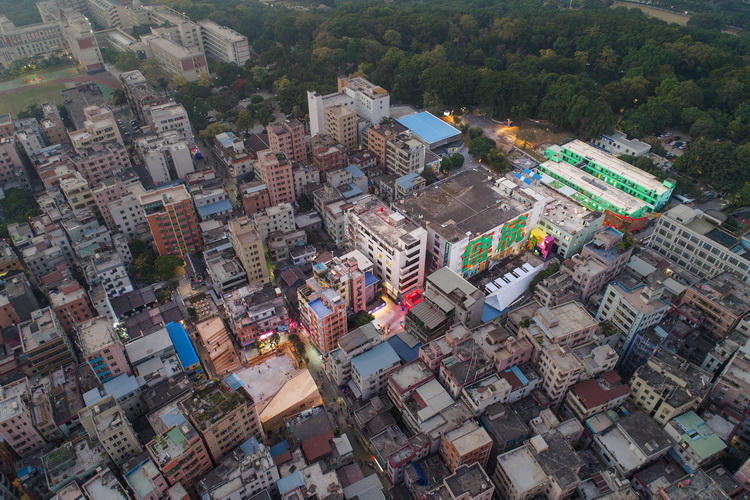
Nantou, A City Or A Village?
For a long time, Shenzhen has been portrayed,sometimes intentionally, sometimes unwittingly,as a young city with a history of only three decades. The myth of how a “small fishing village” has miraculously grown overnight into a modern metropolis is still prevailing in mainstream media and widely persists in the public imagination. The myth is followed by a curse, haunting this Special Economic Zone (SEZ) for many years, that it is a city with no origin, no history or culture.
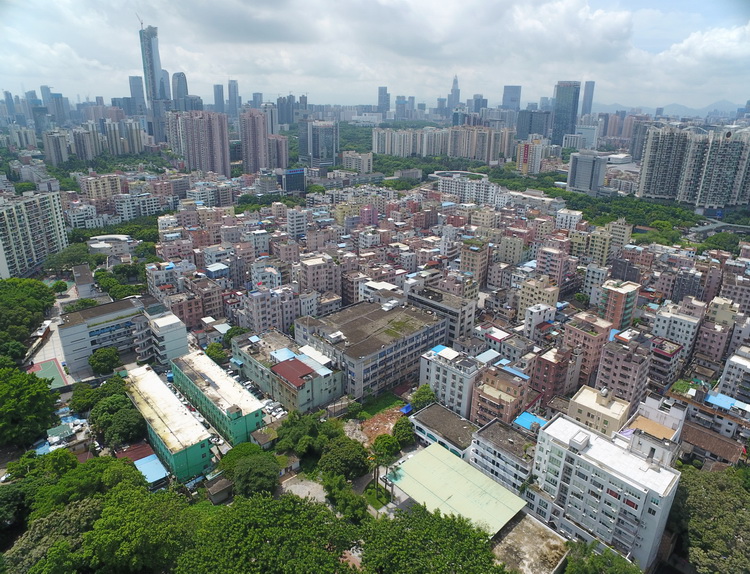
Aerial View of Nantou Old Town and the City (from northeast to southwest)
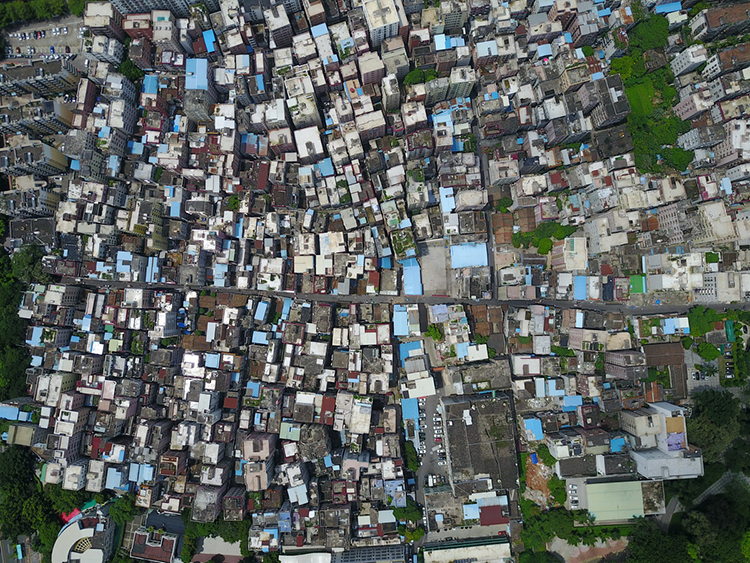
Aerial View of Nantou Old Town
In truth however, the Nantou Old Town in the Nanshan District of Shenzhen was founded as a city over 1,700 years ago during the Jin Dynasty, and it served as the political, economic and military center for the Shenzhen-Hong Kong area during the Ming and Qing dynasties, governing a vast area that included modern day Shenzhen, Hong Kong, Zhuhaiand Macao. In the early Qing Dynasty, the Nantou Fortress was destroyed and abandonedin an evacuation known as “Jin Hai Qian Jie” (Sea Ban and Frontier Shift). It was later restored for use up untilthe early years following the founding of the People’s Republic of China in 1949, when the government of Bao’an County was relocated to another site. From that time on, Nantou became a quiet village surrounded by an old city wall, its history as a city for over 1,700 years fading from memory.In the following decades, with the growth of its economy and population, the village expanded out from the confinement of its ancient wall. The historical buildings inside and outside the city wall were demolished and new buildings built. The Old Town continued to disappear as thevillage grew.
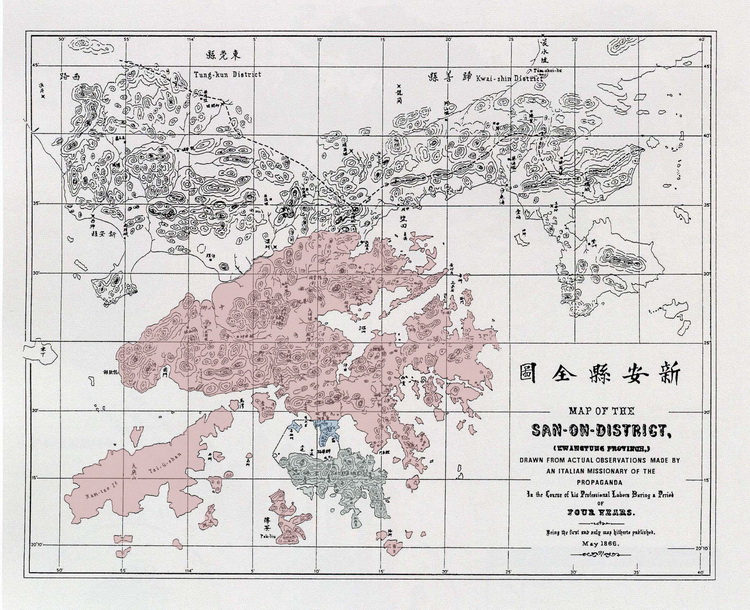
Map of the San-On-Distinct(Historical Map)
After the establishment of the Shenzhen SEZ in the 1980s, urbanization was first dominated by government and state-owned enterprises, followed by a top-down process of implementation by developers that guided by urban planning. Like other villages surrounded by sprawling urban development, Nantou Village experienced a bottom-up and haphazard self-urbanization process in contrast to the planned urbanization around it. This stark difference was due to the historical legacy of the“rural-urbandual-system”oflandownership,combined with the added pressure of a surging market demand, leading to a process of evolution that has been entirely spontaneous and informal. Implemented by the village collective and individuals, this process has been subjected to the pressures of external urban development and yet has benefited from the market demand and the imperfection of urban policy. The restriction that villagers are only permitted to build two-story houses as residences on their own household plot wasbroken, and the function as residence was then shifted to market-drivenapartmentrentals. In order to meet the demands of the market, villagers subsequentlyrebuiltlarger and higher buildings, eventually filling their household plotsas much as possible. This formed a unique urban landscape ofhigh-density clusters of “hand-shake buildings”, what has become a typical spatial fabricof urban villages in the Pearl River Delta (PRD). The urban village is a special alternative urban typology, an economic and social ecosystem formed because of failures in urban governance and the urges of pure economic incentives. It is usually located in the middle of the city, but provides accommodation at comparatively low prices, while also creating diverse local employment opportunities. It therefore acts ashaven for newcomers, a temporary buffer to the city and itsharsh urban environment of fiercecompetition. Today, urban villages in Shenzhen andthe PRDare not rural enclaves surrounded by urban districts, but “urbanized villages” that have been collaged and integrated into current urban reality. To be exact, it emerges asanew“ThirdTypology”—“Village/City” which is different from the prevailingdualsystemof either village or city in China. It is not only the first choice for arrivalbynew immigrants, but also an integrated and indispensable part of the city itself.
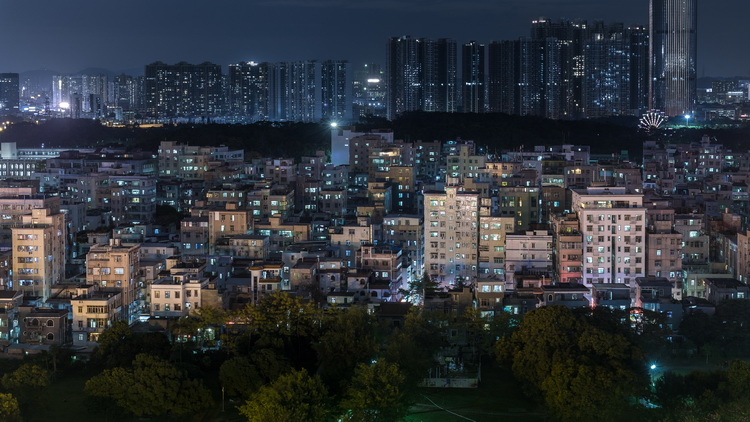
Night View of Nantou Old Town and the City
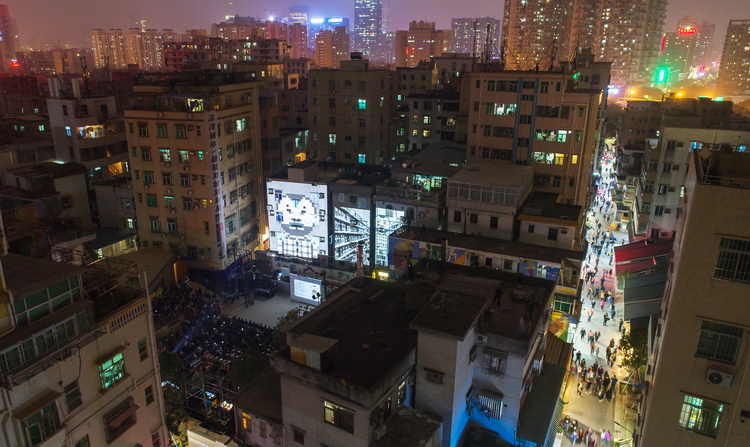
UABB Opening Ceremony in Nantou Old Town
–
Nantou, Old Town Preservation or Urban Village Regeneration?
As compared to other urban villages, NantouVillage has preserved its main street pattern after decades of development. Although the old town has changed dramatically,thesouthern gate and eastern gate still exist, and several ancestral halls, temples, old houses, a church and other historical buildings remain as well. Sites of archaeological significance have also been preserved underground. Today, NantouVillagerepresents a symbiosis of an old town of nearly two thousand year’shistoryand a modernurbanized village. It existsinbetweenacity andavillage, and yet it is neither a city nor a village when history intertwines with reality. Underneath the current hustleand bustleof urban reality, hidden cluesofspatial and historicalmemorycan still be found.
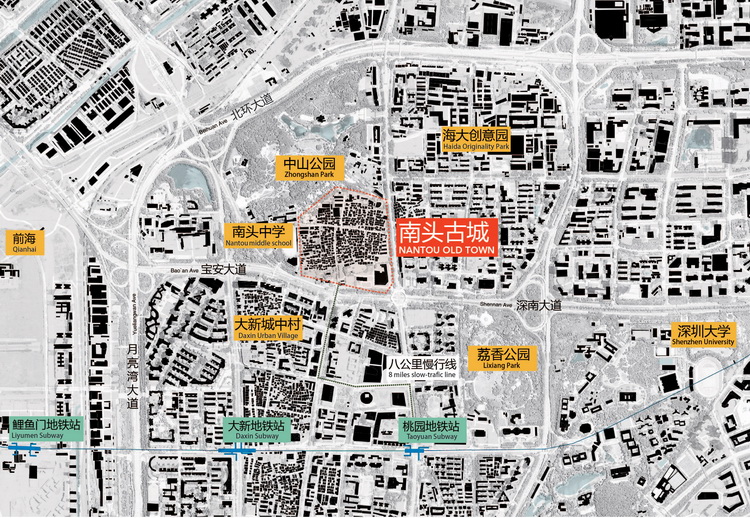
Nantou Old Town Site Map
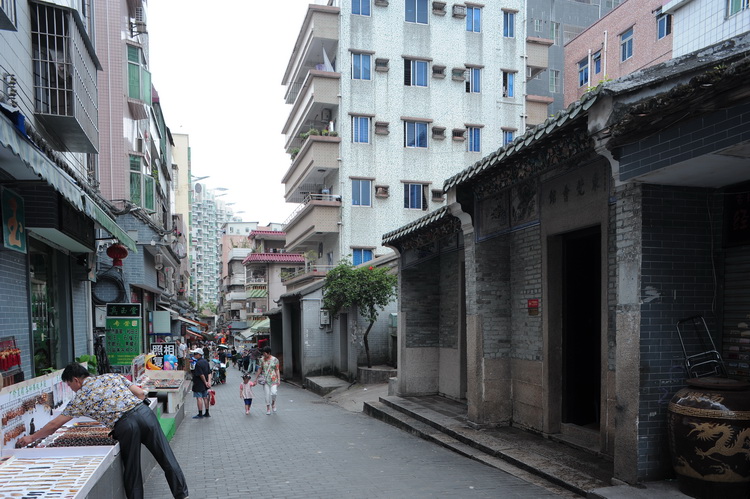
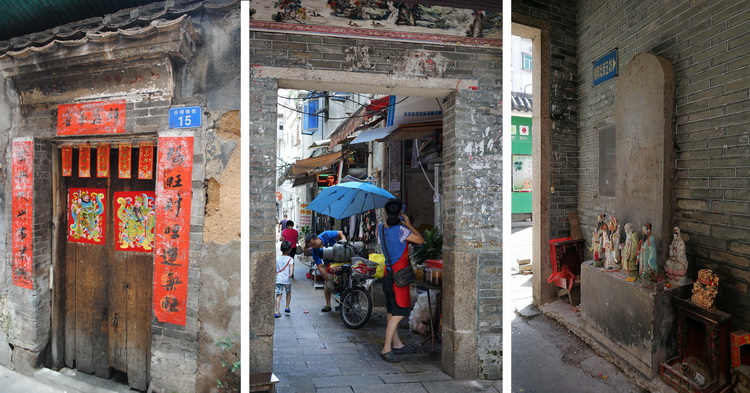
Old Buildings in Nantou Old Town
In the past decade,though scattered preservationand renovation efforts inside and outside of the city wall have neverstopped,Nantou has been in a dilemma whether to protect the historical heritage of the old town or to redevelopthe urban village so as to improve the residents’ livelihood. Local government alsohas been trying to explore the cultural resources and tourist potentialof the Old Town. Numerous studies and design proposals have been prepared, but few of them have been implemented because of complicated factors.
At the beginning of 2016, when the design and research team of Urbanus started to be involved in the NantouPreservationand RegenerationProject, we found that rather than the contradiction between historical heritage protection and urban villageregeneration,the most critical problem that has been hindering Nantou’sfutureis how to define and positionbothitshistoricaland its contemporary heritage; this is the fundamental question that decides its future destiny.By starting with research into the historical context of the ancient city, our team has also carried out detailed field investigations.Through mapping multiple layers of historical informationcomparedwithon-siteobservation and recording,the future blueprintfor the Old Towngradually took shape.Thehistory of NantouOldTownreflectsacondensedandcompleteurbanhistory of Shenzhen. Rather than a spatial renovation, the more needed effortsareto improve the quality of life of its residents and to rejuvenatethe local culture.
We didnumerouscasestudiesregardinghistoric renovation,both in China and abroad, and studied the evolution of theories on historic preservation.We concluded that only by respecting the authenticity of the history and cherishing the cultural layers and historical traces of each period of time can we shape a timelessly dynamic urbancommunity rooted in local history and culture. We see today’s Nantou not as anoldhistoric town in the traditional sense, but as ahistorical heritage town, which carries on the history and culture of nearly two thousand years, and which preserves the spatial, social and cultural heritage of Shenzhen across every historical period. It is the only precious sample of Shenzhen’s urban culture thatdisplays both historicalrelicsalongside a full record of China’s rapid urbanization over the last three decades.
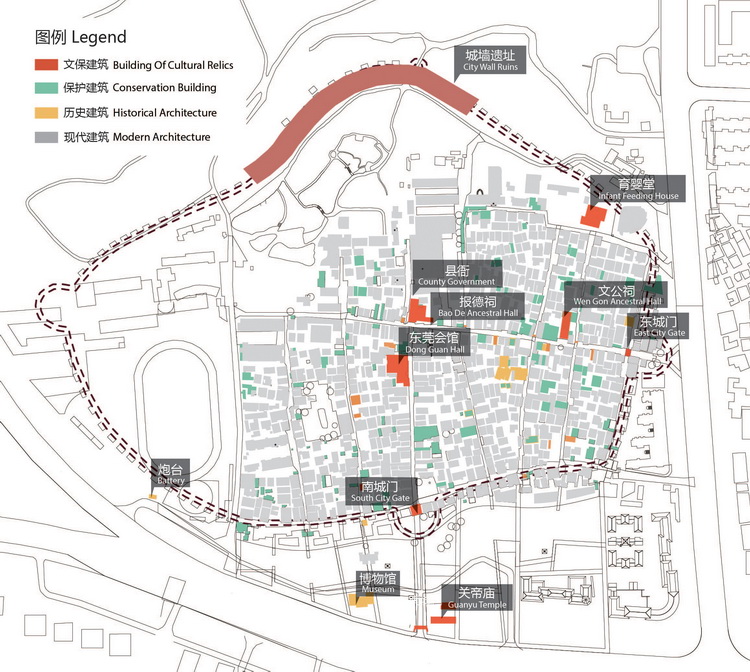
Building Age and Distribution Diagram of Nantou Old Town
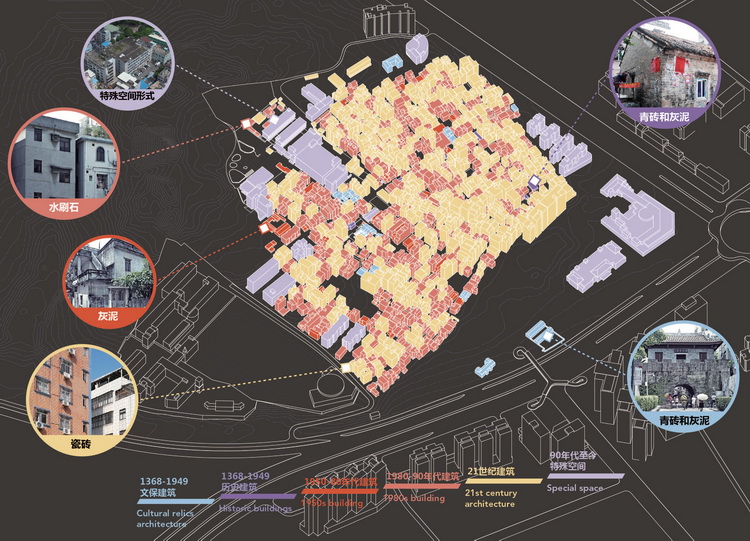
Historical Layers of Architecture of Nantou Old Town
–
City as Exhibition Venue and Exhibition as Practice
Based on the preliminary study onNantou, Urbanus proposed adevelopmentmodelof introducing cultural events,preservation,interventionandregeneration.Adapted to local conditions, we drafted six tailor-made regeneration plans which can be implemented at alater time: Parks and Gardens Revival Plan, City Boundary RedefinitionPlan, HistoricalBuilding Preservation Plan, Main Street Navigation Plan, Creative Factory Plan and Inner City Dynamic Regeneration Plan. These projects mainly focus on the renovation of key public spaces and the introductionofpublic activities as part of the process of activating and promoting the regeneration of the Old Town. Later on, after sufficient field investigation, urban design and research work, we came up with the idea to propose Nantouas the main venueof2017UABB in the biennale venue selection process.
After consensuswas made on the venue, further field surveys and research into Nantou’s history helped usto find a narrative line on which spatial renovation and the exhibition implementation could highly coincide. A series of renovations along with this narrative line will, with most effective interventions, have minimum interference with the daily life of local residents.Theywillimprove the public space quality of the Old Town to a maximum effect, while leaving enough roomfor future development.
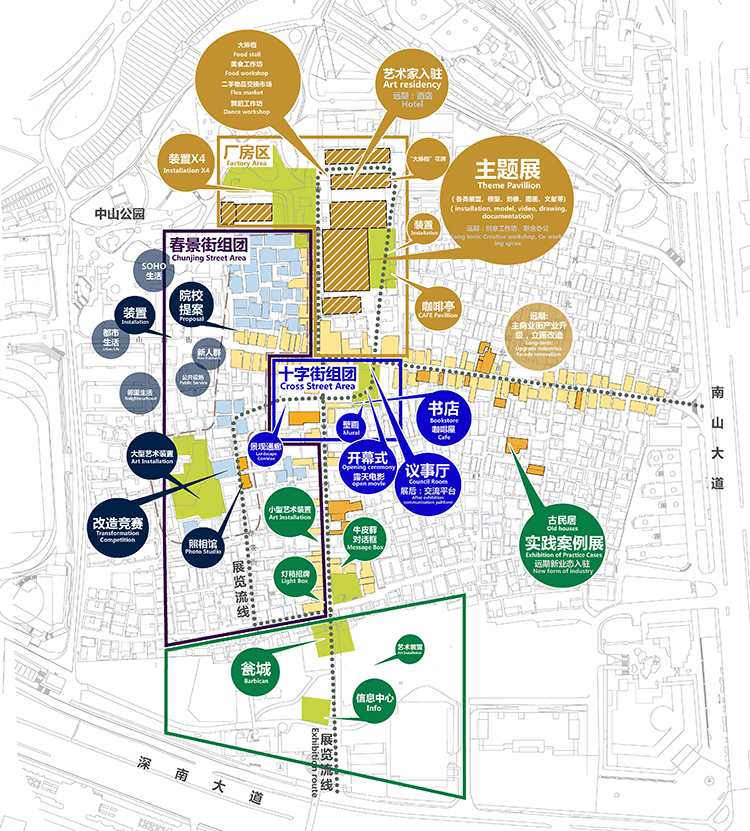
Regeneration of Nantou Old Town
The Nantou Old Town is located to thenorthof ShennanAvenueand south of Zhongshan ark. Built along a gentle slope, the Old Town used to be guarded by four gatesin four directions. The northern gate was abandoned in the middle of the Qing Dynasty, and the northern street in the traditional county town’s “Cross Roads”pattern lost its vitality ever since. Zhongshan Park tothe north of the Old Townwas the earliest public park inShenzhen. It was built during the Republican era of China and featuresold,towering trees that attract manyvisitors. The wall surrounding the factory area constructed in the 1980s separated the park from the Old Town. We decided to reconfigurethis critical node by extending South ZhongshanStreet northward, restoring the traditional “Cross Roads” pattern and reconnecting Zhongshan Park, the Old Town and the Park outside the south gate. This step of spatial restructuring will be the starting point of future old town regeneration, beginning with a series of exhibition venues for the UABB, which will be rolled out alongthis main spine.
Following the urban design strategy of preservation and regenerationwhilelocating exhibition spaces for UABB, we soughtto reconstruct a public open space systeminNantou. Serving as an exhibition route, this system consists of both architectural spaces and outdoor venues. The exhibition venues are in five zones from north to south and extending out toward east and west: A. Factory Zone, B. Cross Road Zone, C. Southern Gate Zone,D.HistoricBuildingsZone,andChunjing Street Zone. The whole exhibition spatial narrative is formed with the following seven interlocking themes, like the structure of Chinese literature or drama.
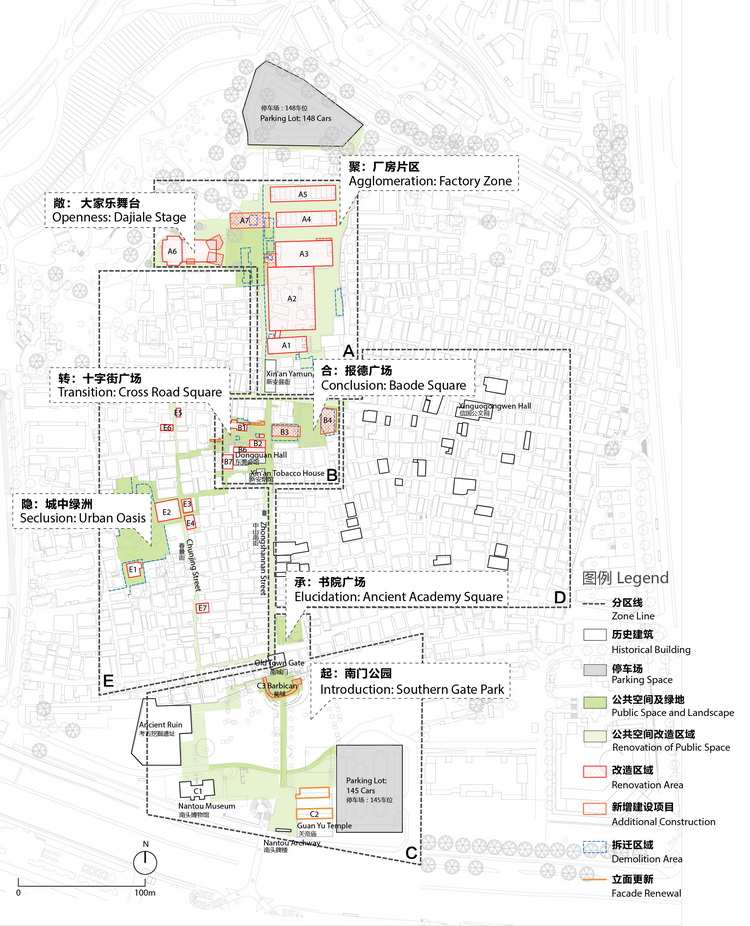
2017 UABB Venue Renovation Plan
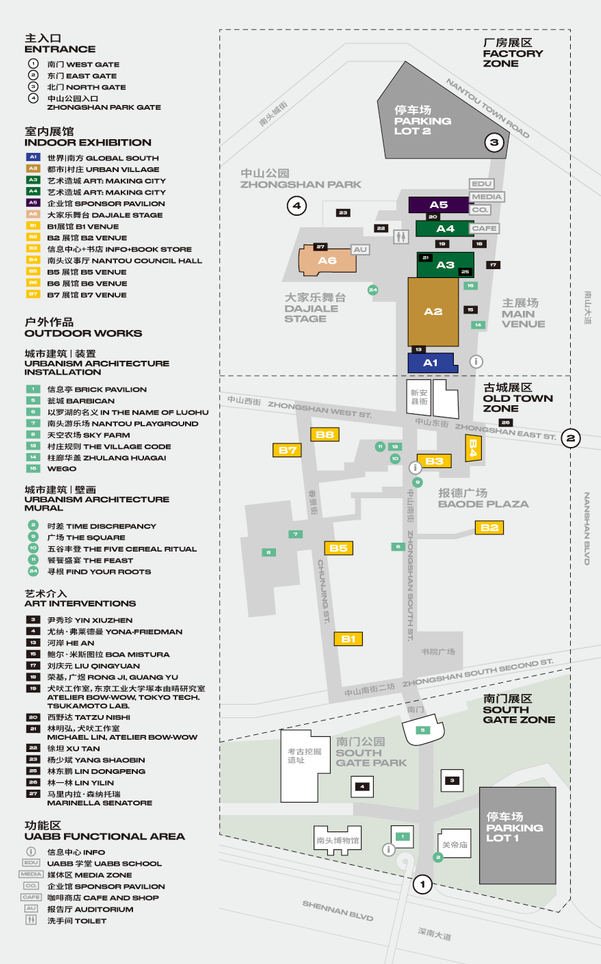
2017 UABB Exhibition Plan
–
Spatial Structure and Narrative of the Exhibition
Introduction: Southern GatePark
The archway to NantouOld Town can be seen when approaching westward from ShennanAvenueafter passing Nanhai Avenue. Guan Di Temple is tothe east, while the Nantou Museum,on the site of the former Bao’an County governmentbuilt in 1950, is not far to the west. Toitsnorth is the excavation site of the moat from the Eastern Jin Dynasty.
The Southern Gate, the only surviving remains of the southern city wall, is the oldest existing structure in Nantou, with a history of 600 years. It is interesting that through laterdemolitionofsome buildings between the Southern Gate and Shennan Avenue, the original footprintof the Old Townhas become clearer. Within the old town perimeter, the densely erected villagebuildings are partially paintedgrey or decoratedwith grey tiles and slopingeaves. Together with some newly-constructed city wall fragments, the efforts to restore the original style of the ancient city can be easily seen. We believe, however, that visual restoration will not help restore the Old Town. Only when urban regenerationis seen as anefforttotackle complexurban problems can we find abalance between history and reality, and between spatialheritage and humanistic lifestyle.
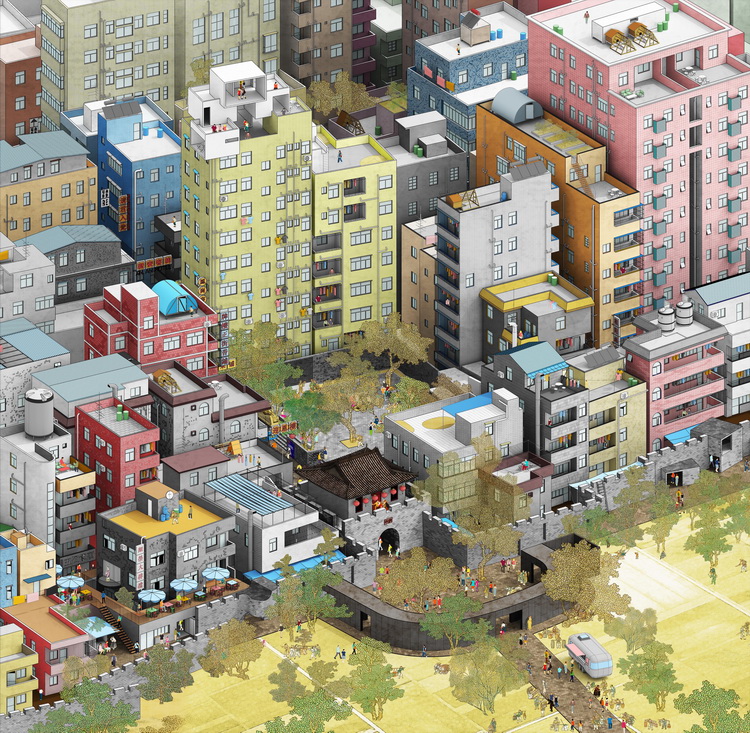
Axon of Southern Gate Park
We hope to establish a connection between the existing cultural sites outside of the Southern Gate and to introduce a new interactive experience in the Park, recreating the spatial prelude before entering the Old Town: walking through the archway of NantouOld Town, a newly built kiosk designed by FCJZ is on the west. Just like a small pavilion by acountry road in ancient times, its overhanging eaves provide shaded seating for travelers; The Guan Di Temple is across the road, with 3D wall murals on its gable, and the contrastbetweensolidbuildingand painted illusionprovokes expectation before entering theOld Town; Atemporary “Weng Cheng” (barbican)plaza installation is on the north, reproducing with light materials the semi-circular barbican of the Southern Gate as it has been recorded in historic literature. The barbican is a symbiosis betweenhistoricfactsand literary fiction, and its temporary popping-up will change people’s daily experience as they pass the ancient city gate. The small semi-circular plazawill be kept after the exhibition, allowing people to stop and to ponder or lament.Rather than a simple rushin and out from the old city gate, a new route of humanistic and historical context will start.
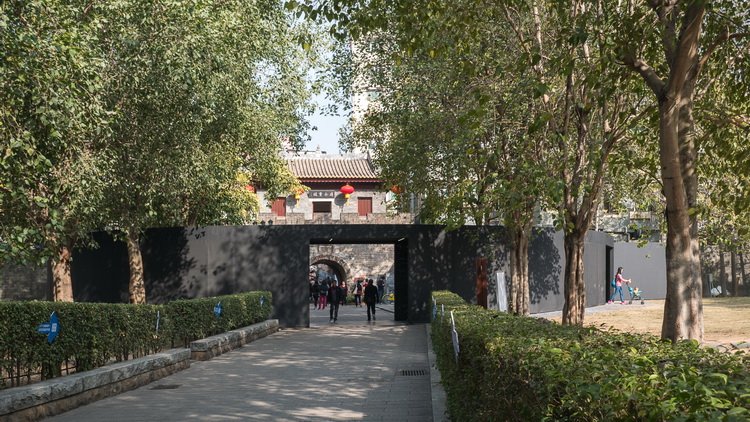
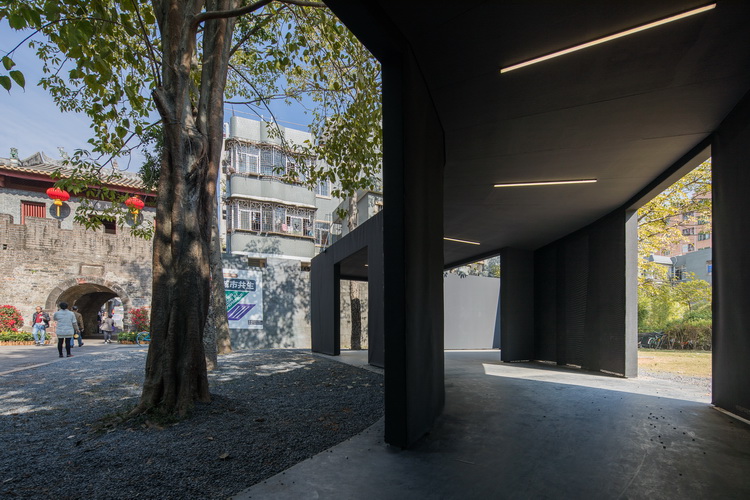
Southern Gate Park After Regeneration (Weng Cheng)
–
Elucidation: Ancient Academy Square
Entering the SouthernGate, one is now standing on the SouthZhongshanStreet, which islined up with many small shops.A small piece of elevated land in an eastern corner is where the Ancient Academy Square is located. According to historical records, the former Office of Coastal Defense was to the east of the modern day square, and in the early 1900’s the Fenggang Academy was established on its premises. It was also the site of the Nantou Middle School and aftermany further changes, the site is currently surroundedbydensely packed villagetowersbehind the eastern and northern walls. In the process of renovation, the original atmosphere of existingtrees and open space is preserved as much as possible,and only the hedgerow is removed from the south of the square to add steps and ramps in order to make the square more open facing towardsthe city gate. A screen wall of grey bricks separatesthe terrace from the street below. A small open space is created in the middle of the square and a small stage is addedalong the northern wall to accommodatesmall-groupedperformances and community activities. This small quiet courtyard with the shade of trees is a nice pocket gardento enjoy the city view, especially from a small porch pavilion in the southeast corner.
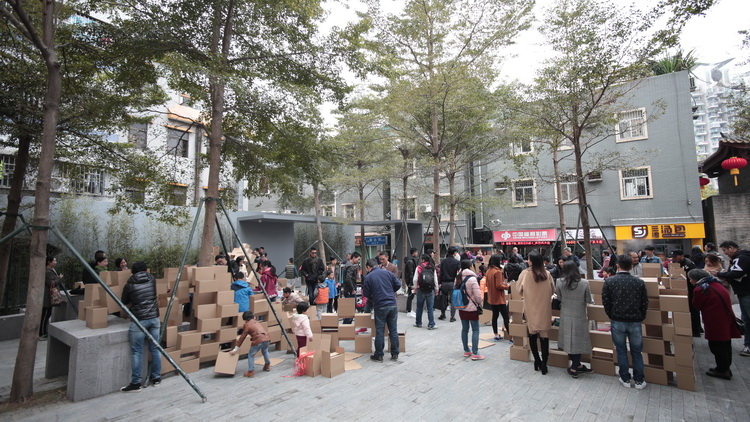
UABB Activity in Ancient Academy Square (After Regeneration)
–
Transition: Cross Road Square
With the surging population living in the old town, most of the traditional houses have been demolished and rebuilt into rental apartments. The Dongguan Guild Hall is one of the few historical buildings that were spared from this fate. There are a couple of other buildings in the vicinity, including the Xin’an Opium Den, the Yili Pawnshop, and the Hongchang Casino, which were all renovated in the 1990s in celebration ofthe reunification withHong Kong. They are closely adjacent to residential buildings of various styles built in the past decades. We chose this small vacant open space, enclosed by traditional buildings andotherresidential buildings, as the junction node connecting the main exhibition venue and the Chunjing Street area to the west of the exhibition route. Gradual spatialtransition is arranged here to separate external street space from semi-public space in the internal block,and the elevation of the site is adjusted responding to the existing topography. Concrete parapet walls are used as the boundary for areas of different elevations, the practice of mixed masonry with greyand red brick in traditional Lingnan(southern Chinese) architecture is adopted in outdoor paving. Localfruittrees, typical in theLingnanregion,are used as the major tree species in landscaping in order to carry on the practical and innovative feature oftraditional Lingnanculture.
For a large number of illegal buildings and structures, instead of a total demolition, categorizedand diversified renovation strategies are adopted, and feedback from the residents are followed in order to make continued adjustments. The basic principle ofrenovation is to make the most of the current situation. Small-sized squares,pavilions, and green spaces are designed atthe major nodes of public activity, responding to the specific conditions of each site in order to compensate for the current scarcity ofopen public space in the old town.They also willrespond to issues like changesin lifestyle, the transformation of traditional spaces, and the scale of Lingnanarchitecture.
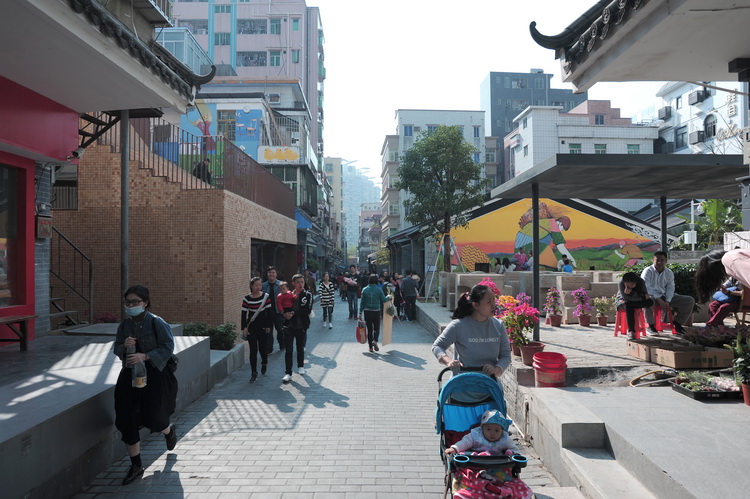
Zhongshan South Street
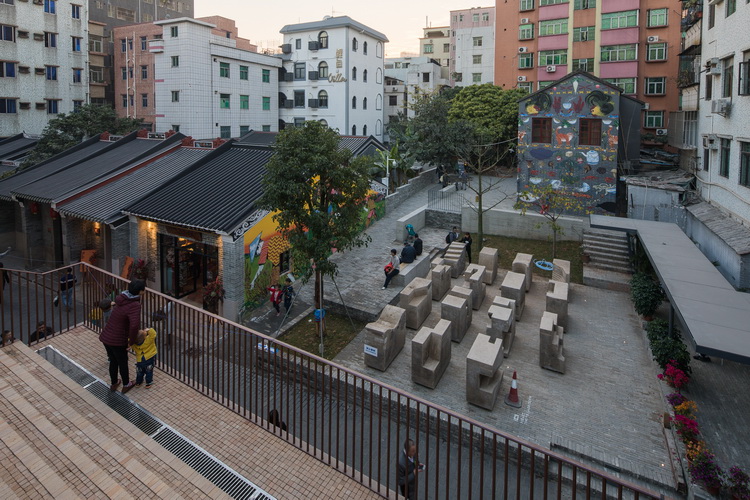
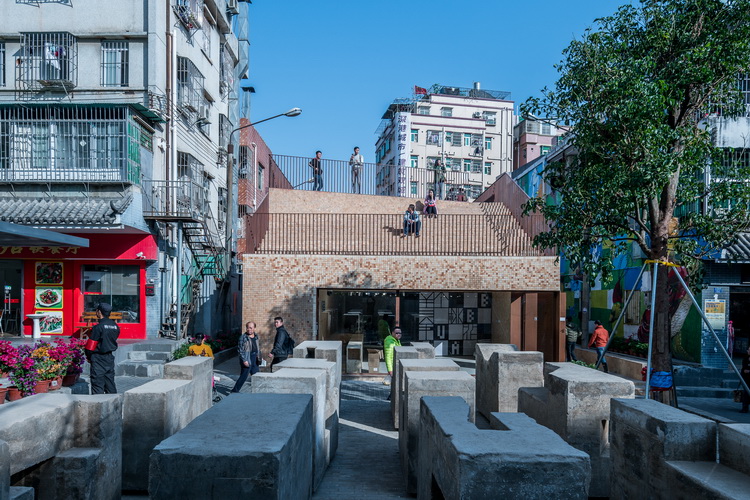
Cross Road Square After Regeneration
–
Conclusion: Baode Square
This areaused to be a small open space in the center of the old town and was later used as a threshing floor in the 1970s. Historic County Government ruins, the BaodeAncestral Hall, and other historic buildings are in the vicinity. The site is surrounded by dense residential buildings built in different periods, with a basketball court of terrazzo floorthat was built in the 1990s. The square is usually empty and unwelcoming in the daytime because of the hot weather, and becomes vibrantafter dark when children are chasing each other and adults are sitting around barbecuing and drinking beer. It is a stage for daily life, shifting betweennoisy and silent, chaotic yet dynamic.
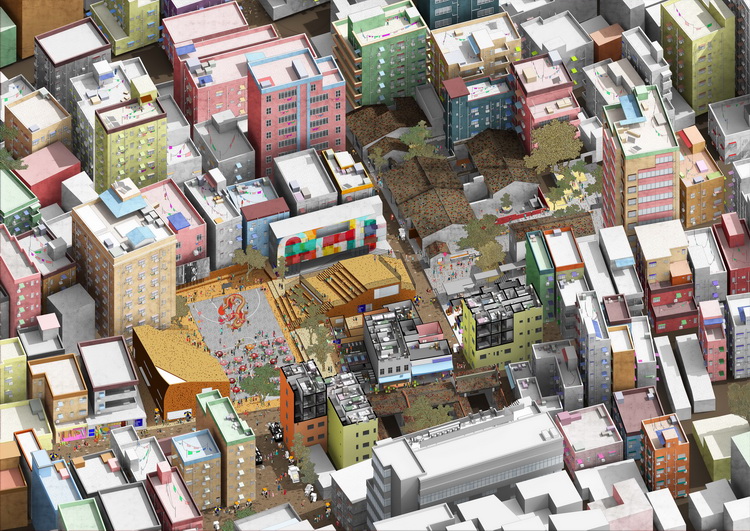
Axon of Baode Square
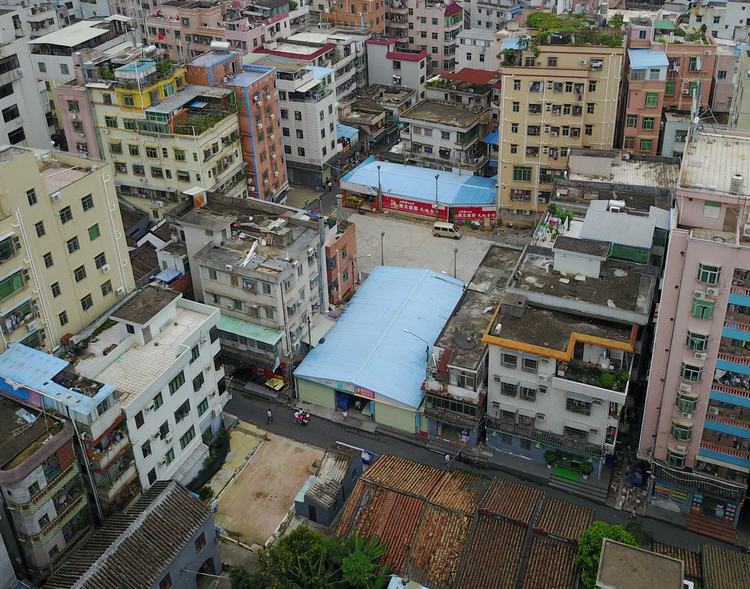
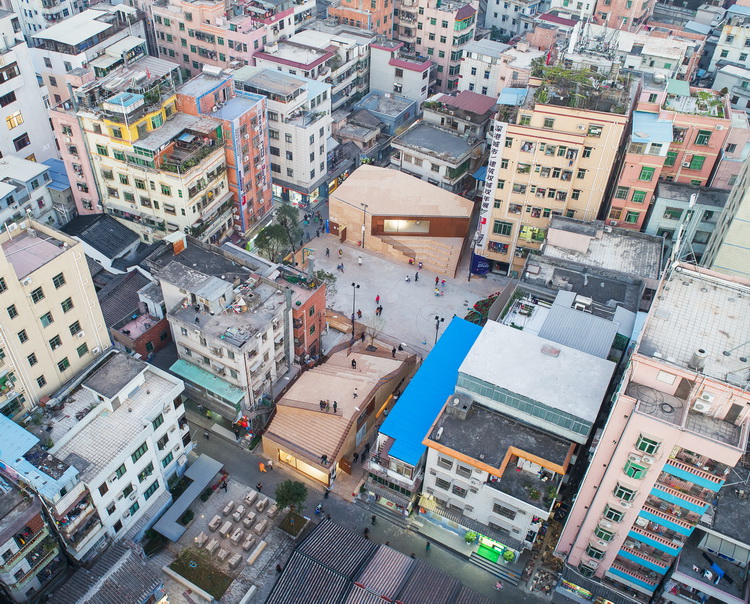
Baode Square (aerial view) Before and After Regeneration
Located on both sides of the squareweretwo metal sheds. Erected on the site of buildings demolished several years earlier, they had served as temporary markets to sell clothing, fruits, and other groceries. The two sheds have been removed and two new temporary structures are built on the site after coordination with local residents. In addition to compensating the same floor area for the village, the new structures have roofs with slanting steps toward the square, forming a continuous interface which allows people to walk all the way from the square onto the roof.Theroof serves as audience seating for basketball games or performances in the square. We also add trees around the square so that even in the summer, the outdoor space is partially shaded. The roof facing South ZhongshanStreet isalso made of slanting steps, forming a roof-top theater; a nice place to enjoy the view of the street and the park.The form of these buildings responds to the small scale and rich roof profileof the adjacent historic buildingsmaking up the Dongguan Guild Hall to the west. Buildings in urban villages are usually finished with a great variety of colors and patterned tiles, and nearby Foshan in Guangdong is the origin of these pottery tiles.We chose a custom-made potterytile as the finish to cover all of the buildings and the square itself, while the terrazzo basketball court is left completelypreserved in the middle. The two new buildings definethe boundary of the square, and abulletin board along the street is redesigned and integrated into the plaza.These efforts help enlarge and extend three-dimensionally the originally limitedpublic space into a hubfor gatherings and sharing. The two buildings will house an information center andbookstore, as well asexhibition and event venues during the upcoming biennale. We hope they will continue to serve the residents in the urban village as a community buildingand culture center into the future.
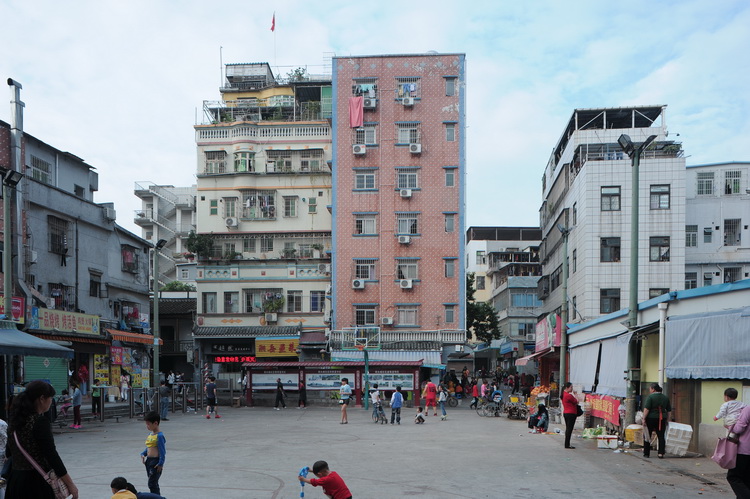
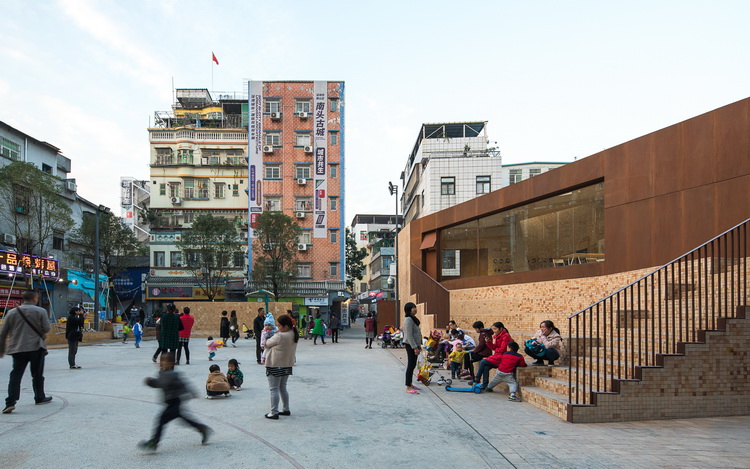
Baode Square (from south to north) Before and After Regeneration
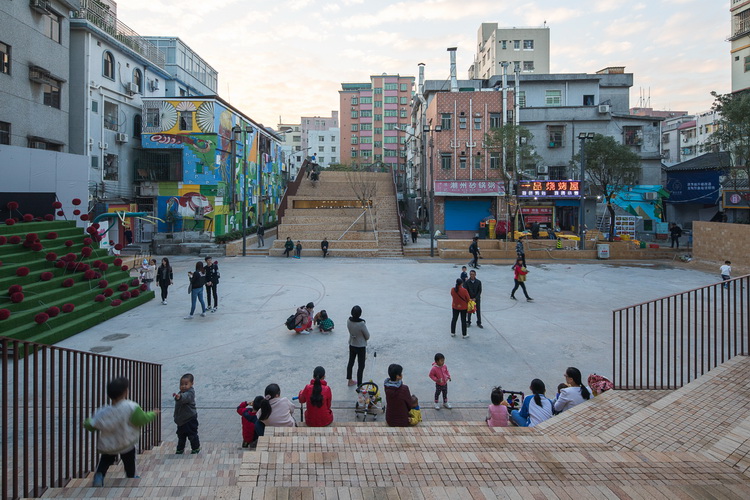
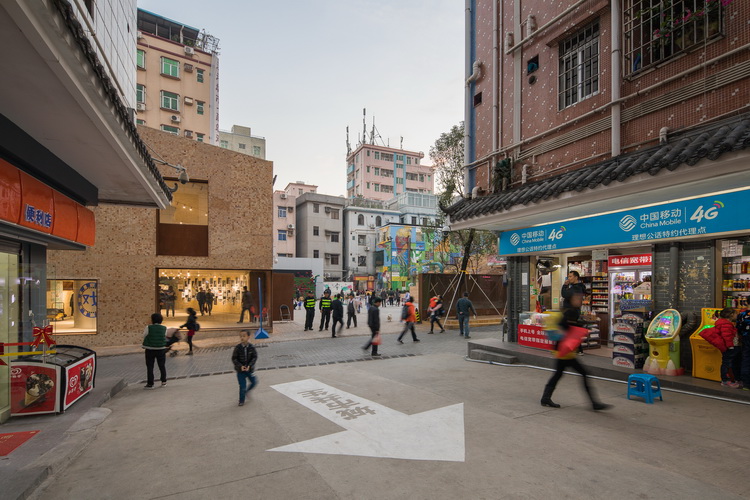
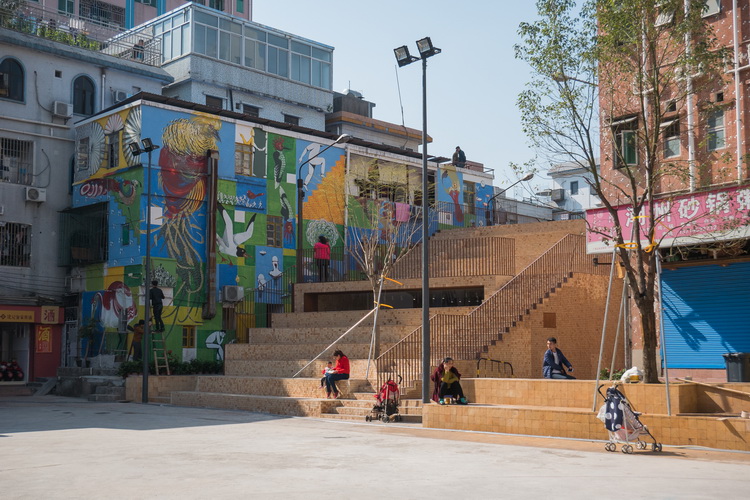
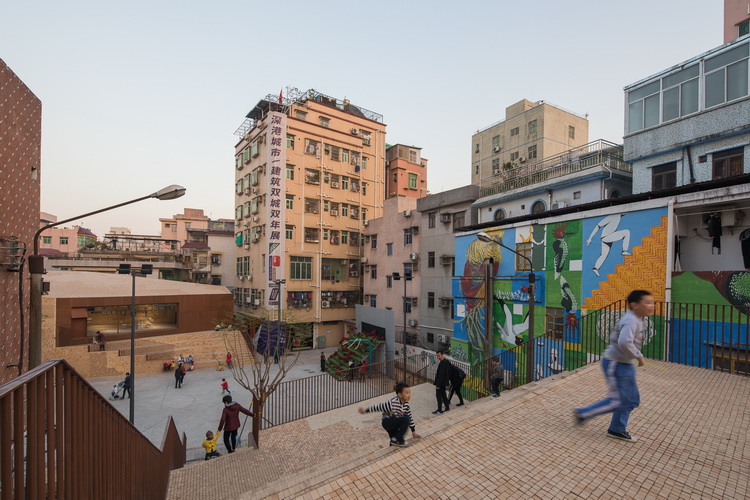
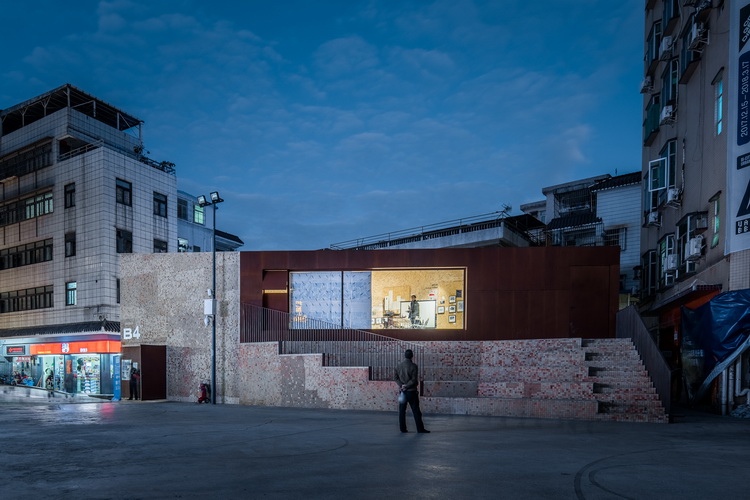
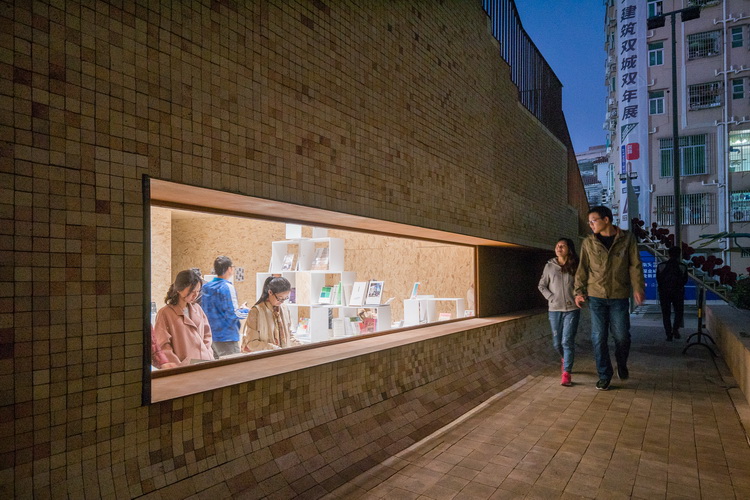
Baode Square After Regeneration
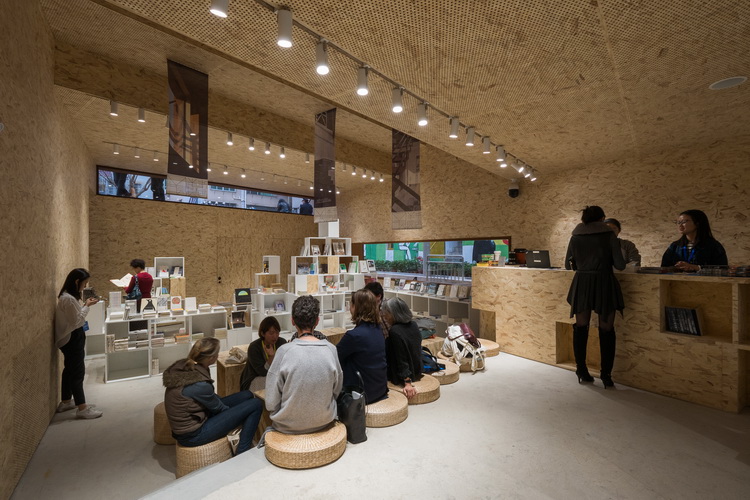
B3 Buliding
–
Agglomeration: Creative Lab and Market Square
In the 1980s, a large number of factories began to be builtinrural areas of Shenzhen and almost every village builtfactorybuildingstorent outasthe quickest wayto shake off poverty and to get rich, while also bringing moreemployment opportunities for the villages’younger generation. As urbanization intensifies and urban districts sprawl to enclose villages, factories inside thesevillages are confined within as well. With the increasing immigrant population and rental demand, urban villagesare becoming the most open, densely populated and highly trafficked sectionof the city,witha mixture of industrial and residential areas. WanliIndustrial Zone of Nantouis located in the northern part of the old town and built in the late 1980s, with a building area of 14,000 square meters. Three plants and two dormitories of the industrial zone are surrounded by enclosing walls, separating the old town and Zhongshan Park to the north. Two factory gates on the eastsitbetweenthe Nantou Town Primary School and the village;there are always residents and school childrenpassing by the square in front of the factory.
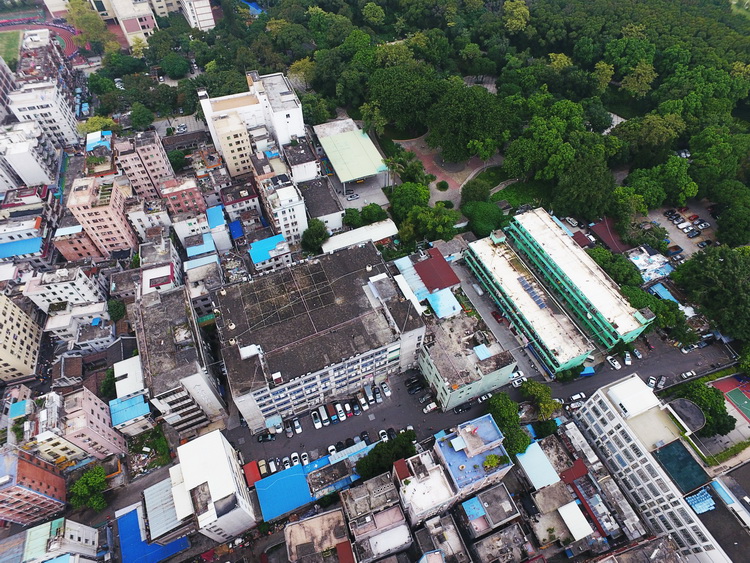
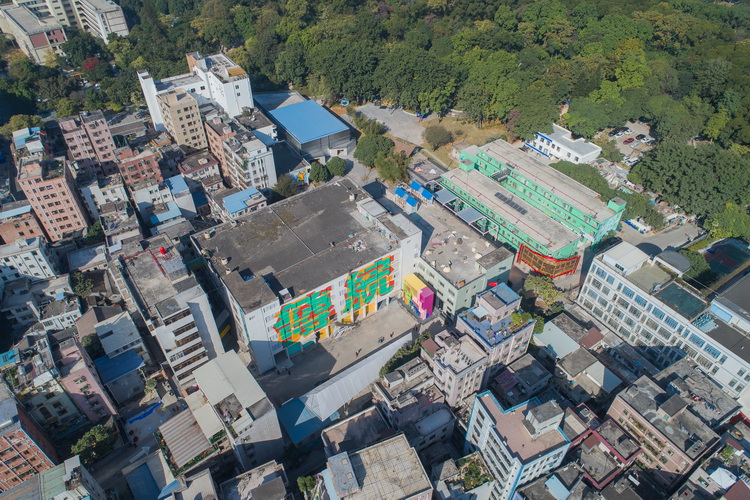
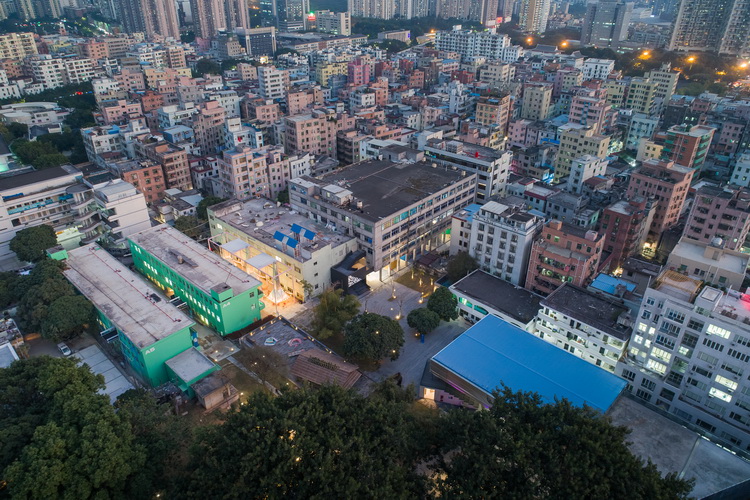
Factory Zone (aerial view) After Regeneration
The exteriorwalls of the factoryand dormitories are essentiallymaintained in theiroriginal appearance. The existing horizontal stripe windows, tinted glass, granitic plaster, mixed pebbles, vertical white tiles,and color mosaicsof geometric patternsare preserved as much as possible.They are typical examples of exteriorwall materials widely used in 1980s and 1990s. Only the large muralpainted on the factorybuildingadds a new stroke to the layeredtraces of time. A temporary metal shedon the factory squareisdismantled, and a light canopy of stretching fabric is built along the eastwalltoaccommodatean open-air café. At dusk, when the canopy is lit up from inside, it looks like a huge lantern floating abovethe square between the factory and village buildings. The enclosing wall on the west side of the factory is demolishedto allow the factoryarea to merge into the surrounding neighborhoods. The exteriorwall of the groundfloor of the main plant is removed,and a north-south inner street connecting the other two buildingsis created. Another intersectingpassage connects the square to the east and the alley on the west side,and eventually leads to the public stage and Zhongshan Park. After opening up the first floor of the mainbuilding, a series of enclosed spaces with different sizes and colors are scattered around.Theywill be used as venues for various themed exhibitions. The irregular alleywaysbetween these big boxes are as complexasa maze,with embedded screens, light boxes, images, posters and bulletin boards on the walls.More contents will be added during the exhibition so that the exhibits will grow spontaneously and the atmosphere will keep changing all the time. Connected with the outdoor square it is like an open market as well as a delightful miniature theme park, suggesting that it couldbe an open creative clusterand a new living communityforyoung people in the old town.
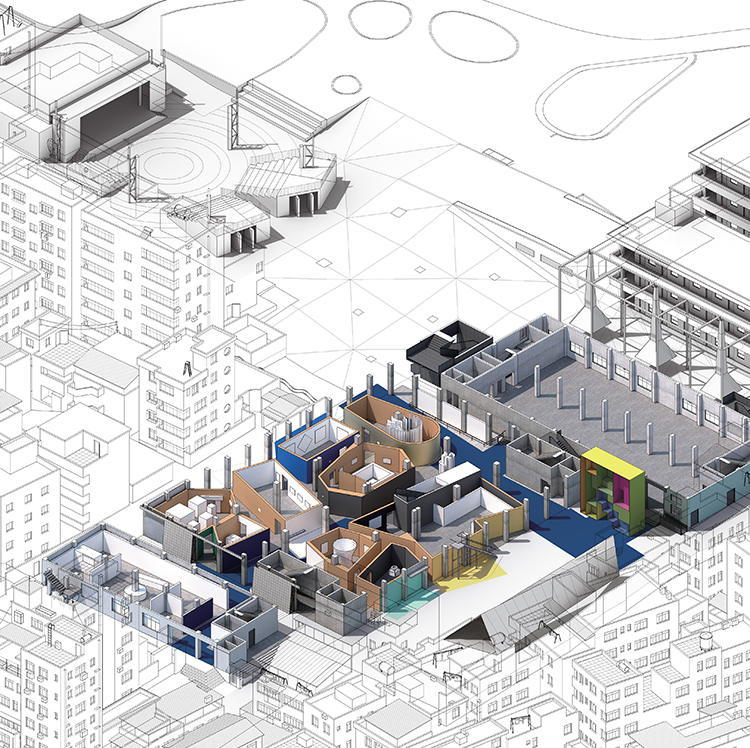
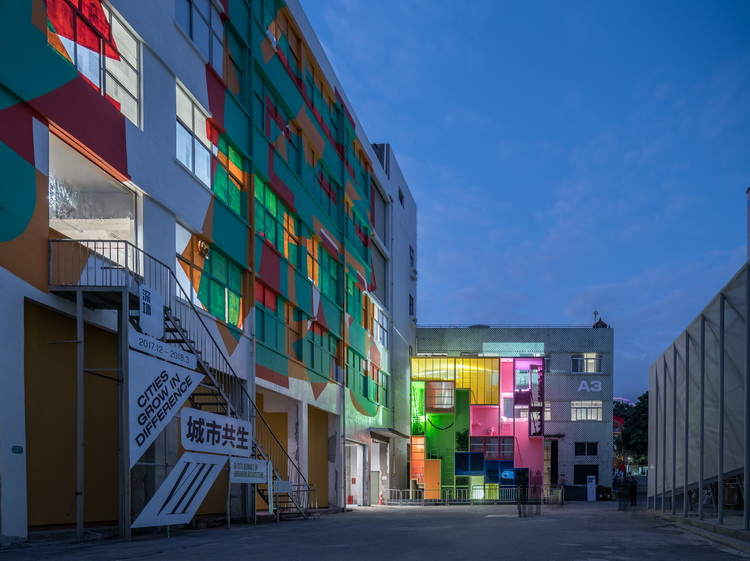
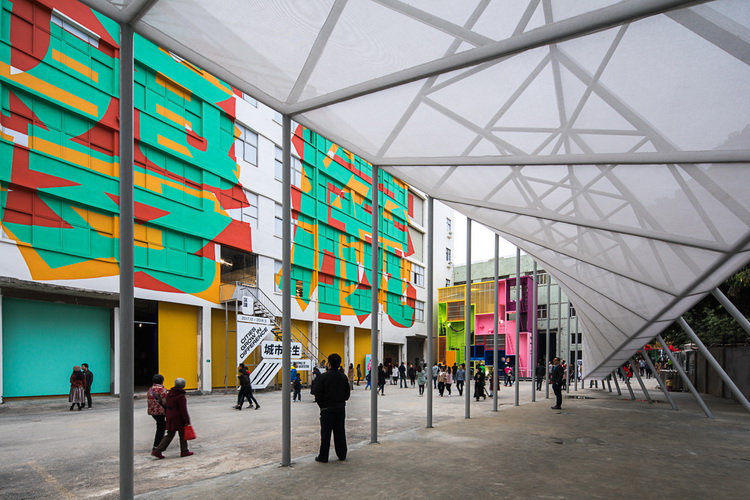
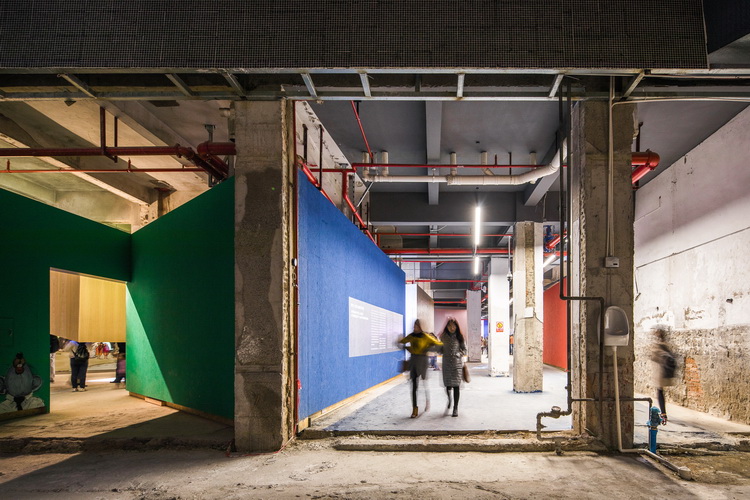
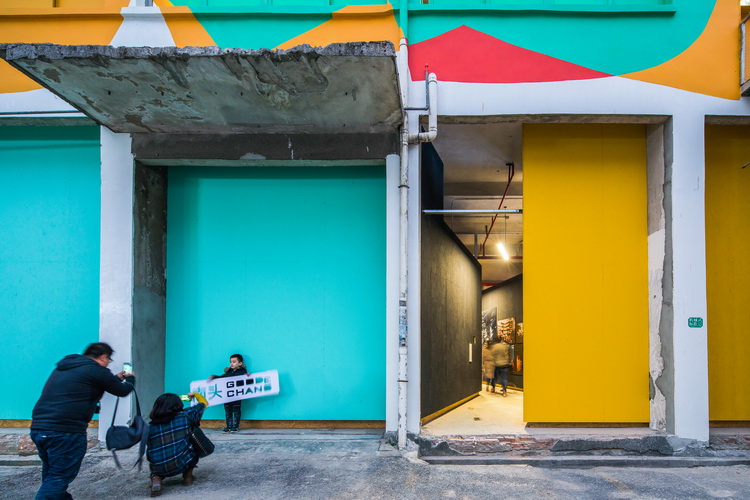
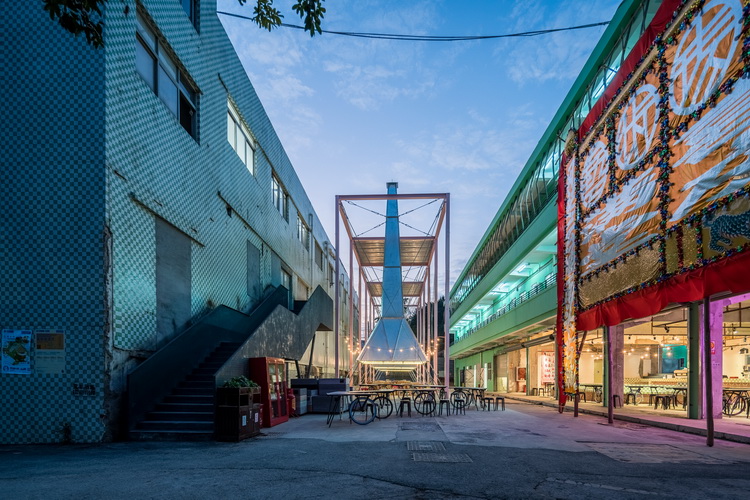
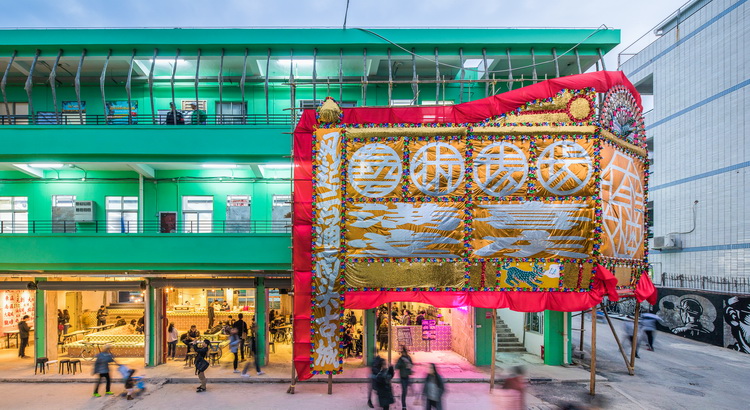
Openness: From Public Stage to Open Theater
The public stage appeared in the late 1980s andwitnessed the early migrant worker culture of Shenzhen. With the rapid industrialization of the city and the thriving of village and township enterprises,public stages were built throughout the city.Theymet the leisure and recreational demands of a large populationof young migrant workers and mass performances of various types used to be seen all over the city. With further growth of the city and the relocation of factories to the outskirts, however, this kind of grassroots recreation gradually disappeared and public stages were dismantled. In Nantouvillage,weare surprised to discover a remaining public stage between the old town and the Zhongshan Park on the north. The south edge of the stage is close to the crowded urban village while the north edge is open to the green space of the park. It is still a semi open-air theater for ordinary peopleto hostamateur performances and local community activities, with a covered seating area for up to 500 spectators. In the summer, old men and women are sitting in the shade to play chess, to read or to watch kids playing. We decided to use this public stage as the multi-function hall during the biennaleto host lectures, seminars, stage performances, films and other activities.Wealso hope to preserve its role as an informal performance venue as much as possible, so that it can still host thedaily activities of local residents when it is available.
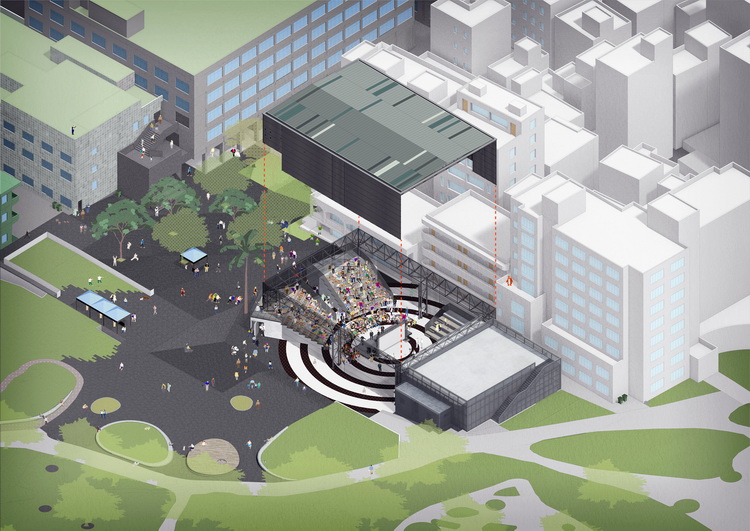
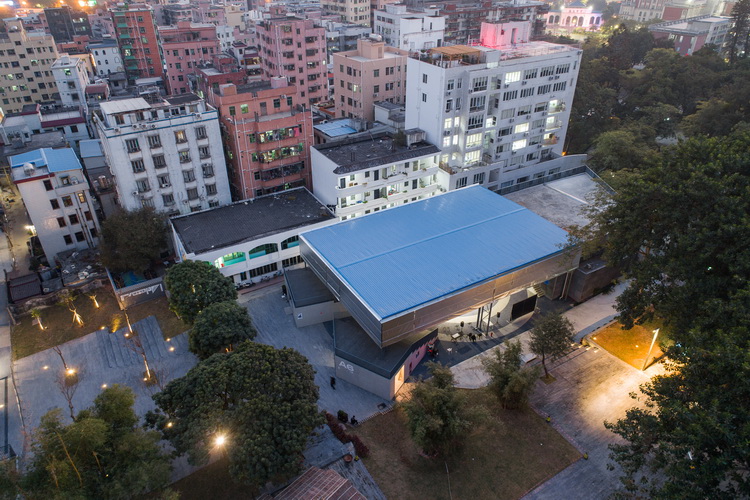
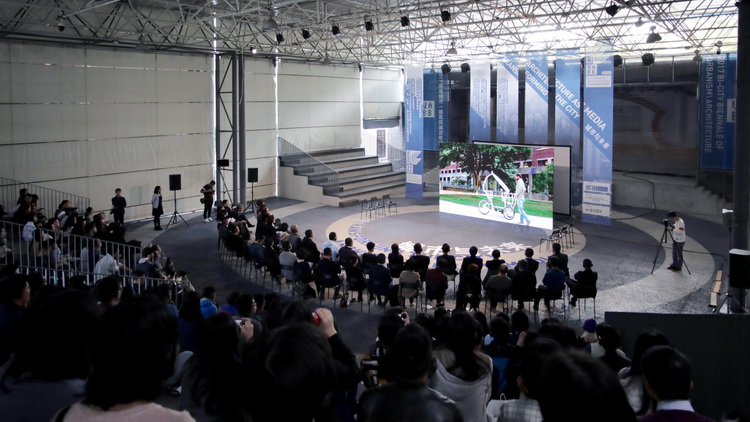
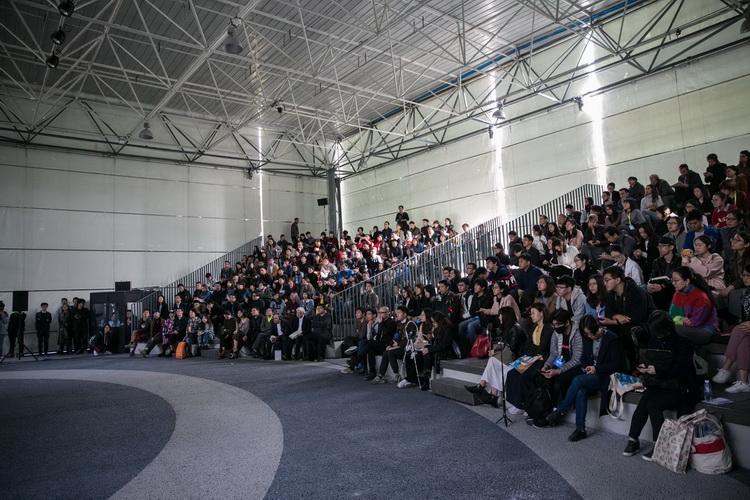
We have placed three raised audience seating areas under the existing steel roof canopy, providing abetter performance atmosphere and better views. The layout of audience seating resembling several scattered rocks creates an atmosphere of an informal theatrical space. A lifting fabric curtain system is designed around the roof truss, making it no longer a closed, static and conventional theater, but a convertible space that can be both open air or closed. A great variety of performances or activities, formal or informal, indoor or outdoor, are made possible when the curtain is lifted or dropped. As the result of the actual interventionofthe biennale, the multiple functions of the public stage will be extended to host thedaily lives of local residents after the exhibition.
–
Seclusion: Urban Oasis
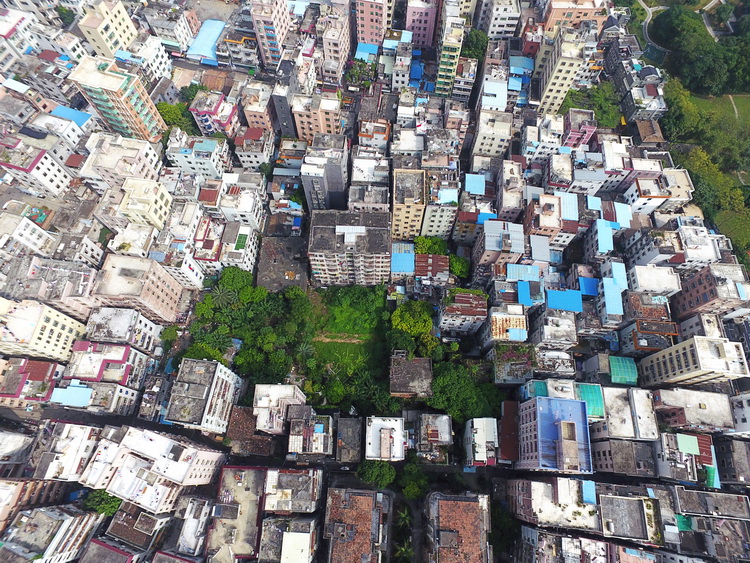
In the center of the old town,there is a piece of land deserted for many years. It is located to the west of Chunjing Street and enclosed on four sides by residential buildings. Historical buildings that once occupied the sitehave beengone for a long time. The site is now enclosed by a barbed wire fence and two uncompleted buildings with exposed steel bars and formwork are visually striking. Local residents spontaneously planted vegetables and fruit trees in the open space and gradually turned it into a hidden oasis. We hope to introduce spatial installations with themes of plants andto organizea small-scale garden tour or planting workshops through UABB to reactivate this area. Our future plan is to dismantle the fenceof the garden and invite botanists, artists, local residents, students and the public to plan their own renovation strategytogether and to build a new community space.
Urban Curation: The Beginning of a Long-term Plan
The 2017Shenzhen-HongKongBi-City Biennale (Shenzhen) themed with Cities, Grow in Difference will soon be heldinNantouOld Town. As the main exhibition venue, NantouOld Town is a heterogeneous symbiosis of a historic town and a contemporary urban village. The urban interventionofthis UABBis highly consistent with the old town regenerationplan, making a smoothtransition from one to theother. During the renovation of the main venue, the design team selected a great variety of spaceswithin the urban village, including factory buildings, streets, squares, residential buildings, historical buildings, and parks. We hope throughrenovation for exhibition spaces, architectureand artinterventions,and organized events to bring an alternative experimentalopportunity for the regenerationofNantouOld Town and the renovation of urban villages in general. “Urban curation,”in contrast to the current urban renewal process,is a long-term strategy for the incremental improvement of urban spaces and the qualityof urban life.
